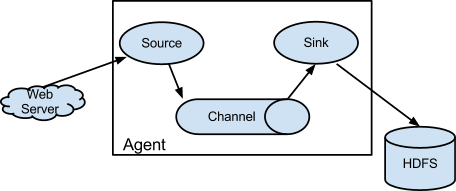Flume的简单使用
一.flume介绍
1.flume是一个分布式的日志采集系统
2.在flume系统中,最核心的是agent,每个agent都相当于一个数据传递员。
在agent内部有source,sink,channel
source是获取数据的来源
sink是采集数据的传送目的,往下一级agent传递或者网存储系统传递数据
channel是agent内部传输通道,用于将数据从source传到sink
3.单个agent采集

多个agent采集

二.flume的简单使用--采集来自端口的信息
1.首先要在flume的conf目录下新建一个文件netcat-logger.conf(文件名自定义)
2.在该文件下编写以下内容
a1.sources = r1 a1.sinks = k1 a1.channels = c1 # describe source a1.sources.r1.type = netcat a1.sources.r1.bind = localhost a1.sources.r1.port = 44444 # describe sink a1.sinks.k1.type = logger # describe channel a1.channels.c1.type = memory a1.channels.c1.capacity = 1000 a1.channels.c1.transactionCapacity = 100 # describe the ralationship between source channel sink a1.sources.r1.channels = c1 a1.sinks.k1.channel = c1
注意:最后一行的a1.sinks.k1.channel就是这么写,而不是a1.sinks.k1.channels
3.启动flume
在flume目录下输入如下命令
bin/flume-ng agent -c conf -f conf/netcat-logger.conf -n a1 -Dflume.root.logger=INFO,console
其中 -c是指定配置文件所在目录
-f是配置采集方案的文件
-n是指定我们的agent的名字
-Dflume.root.logger=INFO,console 是设置日志等级
4.测试
首先打开telnet,并向flume监听的端口发送消息
telnet localhost 44444
这时候在telnet发送的消息,flume都会在终端打印出来
telnet发送内容:

flume采集到的内容:

三.flume的简单使用--采集文件流信息
1.首先要在flume的conf目录下新建一个文件netcat-logger.conf(文件名自定义)
2.在该文件下编写以下内容
a1.sources = r1 a1.sinks = k1 a1.channels = c1 # describe source a1.sources.r1.type = spooldir a1.sources.r1.spoolDir = [监测的本地文件目录地址] a1.sources.r1.fileHeader = true # describe sink a1.sinks.k1.type = logger # describe channel a1.channels.c1.type = memory a1.channels.c1.capacity = 1000 a1.channels.c1.transactionCapacity = 100 # describe the ralationship between source channel sink a1.sources.r1.channels = c1 a1.sinks.k1.channel = c1
3.启动flume
在flume目录下输入如下命令
bin/flume-ng agent -c conf -f conf/netcat-logger.conf -n a1 -Dflume.root.logger=INFO,console
其中 -c是指定配置文件所在目录
-f是配置采集方案的文件
-n是指定我们的agent的名字
-Dflume.root.logger=INFO,console 是设置日志等级
4.测试
首先向待检测目录粘贴一个文件
flume采集之后会在终端输出信息

在检测目录中,传入的文件会被修改文件名,即在文件名后边添加.COMPLETED.
四.flume的简单使用--采集文件流信息到hdfs
1.首先要在flume的conf目录下新建一个文件netcat-logger.conf(文件名自定义)
2.在该文件下编写以下内容
a1.sources = r1 a1.sinks = k1 a1.channels = c1 # describe source,here is the file test.log a1.sources.r1.type = exec # we will wirte something to the test.log a1.sources.r1.command = tail -F [本地文件路径] a1.sources.r1.channels = c1 # describe the sink a1.sinks.k1.type = hdfs a1.sinks.k1.channel = c1 a1.sinks.k1.hdfs.path = /flume/events/%y-%m-%d/%H%M/ a1.sinks.k1.hdfs.filePrefix = events- a1.sinks.k1.hdfs.round = true a1.sinks.k1.hdfs.roundValue = 10 a1.sinks.k1.hdfs.roundUnit = minute
# 以下三个条件满足一条就会将记录下沉到hdfs # 条件1:时间间隔是3s a1.sinks.k1.hdfs.rollInterval = 3 # 条件2:文件写入字符数量超过500字节 a1.sinks.k1.hdfs.rollSize = 500 # 条件3:文件的更新事件超过20条 a1.sinks.k1.hdfs.rollCount = 20 a1.sinks.k1.hdfs.batchSize = 5 a1.sinks.k1.hdfs.useLocalTimeStamp = true a1.sinks.k1.hdfs.fileType = DataStream a1.channels.c1.type = memory a1.channels.c1.capacity = 1000 a1.channels.c1.transactionCapacity = 100 a1.sources.r1.channels = c1 a1.sinks.k1.channel = c1
3.启动flume
在flume目录下输入如下命令
bin/flume-ng agent -c conf -f conf/netcat-logger.conf -n a1 -Dflume.root.logger=INFO,console
其中 -c是指定配置文件所在目录
-f是配置采集方案的文件
-n是指定我们的agent的名字
-Dflume.root.logger=INFO,console 是设置日志等级
4.测试
首先要建立一个本地文件,之后要定时写入数据定时写入数据脚本如下,直接在终端输入这些命令就可以做到定时向文件写入数据"1111"
while true do echo 1111 >> [文件路径] sleep 1 done
之后在flume终端会打印消息

此时查看hdfs,会发现指定目录下也会有文件产生

此时说明数据已经写入到hdfs


